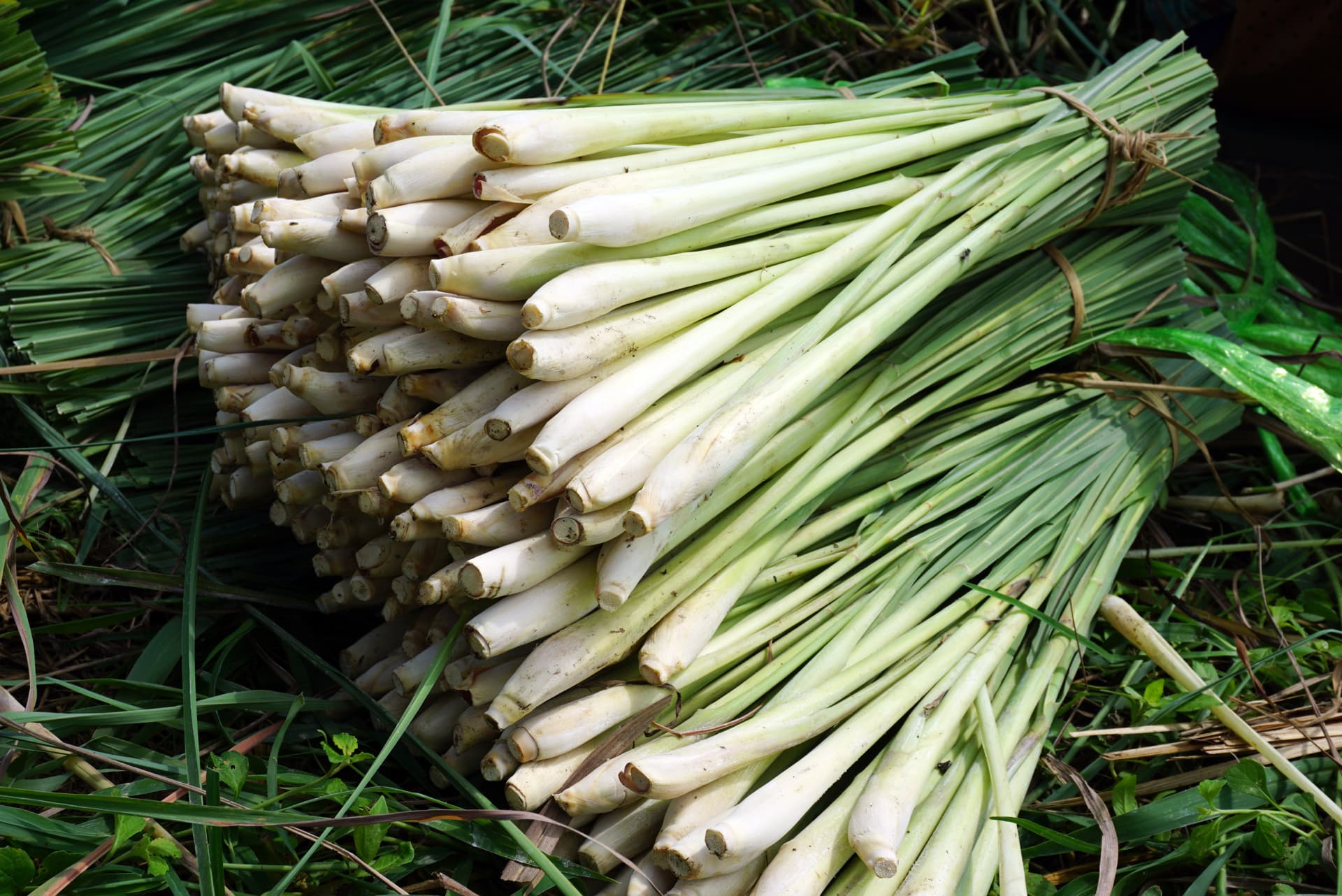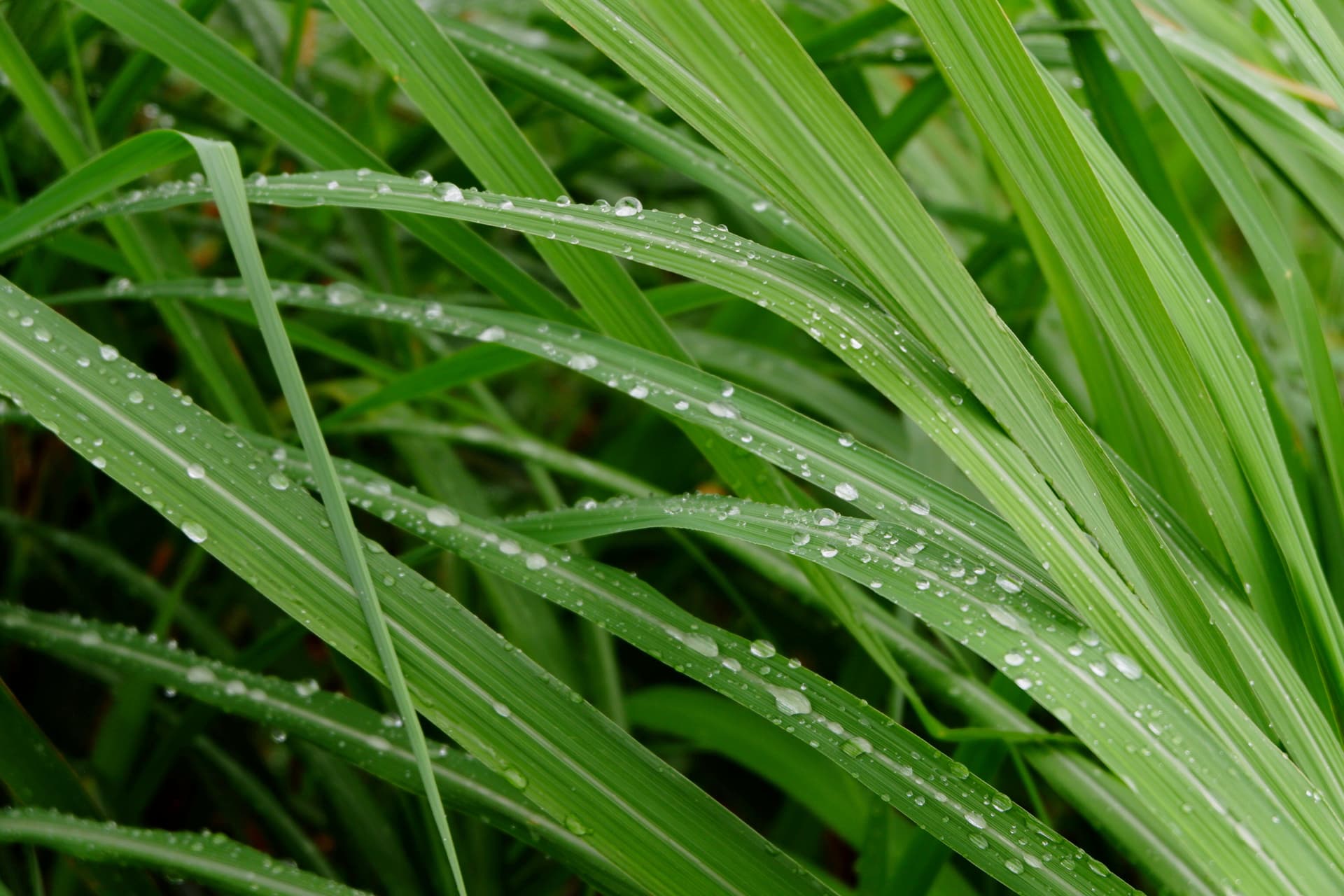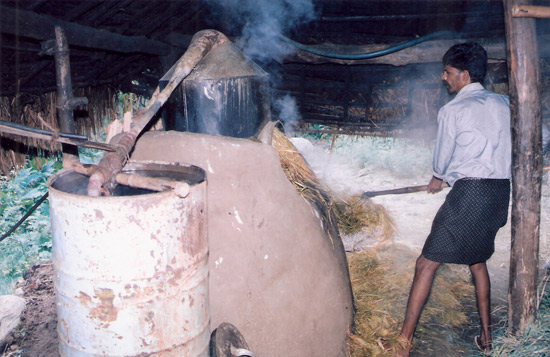One of the most anti-microbial oils so far known is distilled from Lemongrass oil. This oil is derived from a highly fragrant tropical grass belonging to the Poaceae family, the same family as our barley or wheat.
The essential oil in Lemongrass is gained by steam-distillation resulting in a watery liquid of dark yellow colour with an intense fragrance due to the main component, the aldehyde “citral”. The higher the portion of the citral the more potent the desired effects of the essence will be.

There are two main members of the Lemongrass family which have been used for centuries in folk traditions due to their obvious medicinal, culinary and aromatizing value: The West Indian Lemongrass (Cymbopogon citratus ) is native to countries like Malaysia Sri Lanka, and India, especially the south. It has influenced popular perfume- and remedy practices ever since, especially in the Ayurvedic healing tradition and aromatherapy of India. It is also known as an important spicy ingredient within the kitchen recipes of many countries all over the world. Nowadays, Lemongrass is commercially cultivated as a crop in regions like China, Vietnam, Thailand, Malaysia, and Indonesia especially as a herb for the Asian cuisine. In more recent times it has been brought also to countries of the western hemisphere like Brazil, Guatemala, and other regions.
The East-Indian Lemongrass on the other side (Cymbopogon flexuosus ), also called Malabar Grass, originates in countries like Cambodia, India, Burma, and New Guinea. In India Lemongrass is also referred to as “Indian Verbena” or “Indian Melissa”. Within the cultural history of the Indian subcontinent, the essential oil due to its hydrophobic property has also been used as an effective preservative. It has even helped to protect ancient manuscript collections against decay by humidity like the palm-leaf manuscripts or the written heritage of the Saint Thomas Christians.
Manifold uses
Widely applied for its culinary qualities Lemongrass is also a herb that is used in the cuisines of South- and South-East-Asia. The plant occurs in Indian, Indonesian, Thai, and Malaysian dishes, contributing its spicy freshness to vegetable recipes, poultry, fish, and other sea fruits as well as to teas, marinades, sauces, and pickles. It is said to balance digestive disorders and easing ailments of the stomach.
The plant can also be used by breathing in its fumes or by directly applying it to the skin. Lemongrass oil, exposed to research studies, proves to have anti-fungal properties. Such validated qualities have been exploited for centuries on a broader scale of antimicrobial and antibacterial knowledge of ancient herbal medicine. The well-known Ayurvedic and Chinese therapeutic systems knew about the special healing properties of Lemongrass. Their indication lists included knowledge of the sedative calming and even analgesic effects of the herb to reduce sensations of pain within the human body. Boosting the parasympathic system and combating nervous exhaustion, it is a wonderful revitalizer and beneficial to periods of regeneration after sickness.
On the other hand, due to its refreshing and rejuvenating properties, Lemongrass also plays a remarkable role within the perfume and hygiene industry. It is an important ingredient in many citrus-type soap articles, deodorants, and detergents. In the realm of skincare, Lemongrass as a constituent of massage oils benefits aching muscles under tension helping them to release stress. As such it tones tissues and muscles and helps to open blocked pores against acne and oily skin as well as clearing cellulite.
The main chemical constituents of Lemongrass are: citral (most active ingredient ), myrcene, geraniol, limonene, terpineol, alpha-pinene, coumarin, and others.
Lemongrass blends well with oils of Geranium, Lavender, Jasmine, Cedar wood, Coriander, Basil, Tea tree, and oils of the Citrus family.

The power and magic of leaves
Lemongrass grows with more than 50 different species in warm and sunny regions of subtropical and tropical climates all over the world. It prefers sandy soils its growth being much favoured by humid weather conditions. The perennial fast-growing and aromatic grass with its green to blue-green foliage and white flowers reaches a height of up to 3 – 5 feet. It unfolds its leaves in a circle-shaped bunch radiating to all directions. Being cut or bruised the herb emanates a distinct lemon-like scent. The penetrating sweet freshness of the plant’s leaves fills the air with a clear and lucid aroma.
It is always like a miracle how plants, with the help of their green leaves and the process of photosynthesis, can construct their physical “carbon-body” via a special innate densification process by breathing in CO2, breathing out Oxygen, and drinking water from the roots and leaves. As to the growth circuit, the “parallel” perspective with us humans is obvious. The plant is built in the “rhythm” of its stem with its knots and leaves thus making the process of light capturing from the Sun, Moon, and Stars possible. And man is built in the “rhythm” of the spine as his “stem” with its vertebra and rips which themselves envelop and protect the rhythmic organs of the heart and lungs, and – through the spinal axis – make the rise and flow of the “inner light” possible.
But not only that! Numerous plants create in the same process volatile aromatic liquids in the tiny little glandular cells in and on the leaves. Lemongrass is definitely a champion as a “light capturer”. We say “Lemon-GRASS”, but yes, what a grass! One can nearly get lost standing in a dense Lemongrass field, not only overwhelmed by the height of the plants but also by their incredible fragrance streaming out from their leaves.
“Plants ‘eat’ so to say cosmic and stellar energies. It is with their leaves that they suck in the vital forces, hidden in the waves of light, store them in their tissues and – by allowing themselves to be ‘eaten’ – transmit these vital forces to other creatures.” (Wolf-Dieter Storl, “Pflanzen-Devas – die geistig-seelischen Dimensionen der Pflanzen.”)
It is true: Sunlight simply underlies the totality of plant life creating the basis for photosynthesis, the „synthesis or combined transformation through light“. Thanks to their chlorophyll on their leaves plants act like bio-photonic power blocks. Chlorophyll, the “green leaf magician”, is the master engineer in this process – capturing the energy of the Sun and transforming his light into biochemical energy and from here into the real matter.
Thus the plant body rises high up to the sky and dives deep down into the soil, following with its gravitational and anti-gravitational dynamics a fundamental principle of life: the “above and below paradox” – means: coexistence of opposites for evolution. And the green magic of the leaves makes this possible: mediating between the root (=earth level) and the flower (=astral level), the YIN, and the YANG of all physical existence. And here in this energy exchange, the plant becomes the great transformer: production of carbohydrates or sugar – be it for a tiny forget-me-not flower or for a huge Sequoia tree. Or be it for starch, rubber, wood, vitamins, oils, amino acids… or essential oils. Not to forget: Photosynthesis on our planet is responsible for 100 – 200 billion tons of organic matter every year, as explains Wolf Dieter Storl in his excellent book “Pflanzen-Devas – die geistig-seelischen Dimensionen der Pflanzen.”
“Plants transmit to us the primordial sound or mantra of the Universe and thus offers life to us. Plants are able to connect the here and now with the beyond. In the sacred language of the Vedas plants are called Oshadhi (Aushadhi). The meaning of this word is “OSA” (burning transformation) and DHI (vessel). In this sense, plants are considered vessels for creating a metamorphosis of the cosmic fire.” (Wolf-Dieter Storl, “Pflanzen-Devas – die geistig-seelischen Dimensionen der Pflanzen.”)

And this is how, from oxygen, hydrogen, and carbon the plant, according to its specific genetic code, will create its “skeleton” or hardware. Only in certain cases the sugars or starches which it has created, again with the help of the Sun, will be transformed into essential oils which the plant will store in specific glands – and which it will even „consume“ to a certain degree if it lacks Sunlight due to sudden climatic changes. Glucose or starch, essential oils, carrier oils, waxes… – nothing but materialized Sun-energy via the alchemy of the leaves for helping precious life processes to expand in the Universe.
So, let’s praise the leaves of the world of plants! For in every leaf the sun has taken shape and colour, beautifully refined, magically transformed, the alchemy of the Cosmos, Spirit crystalized in Light to create the blue sky of the world and give food and oxygen to our planet thanks to this „green breathing“ through eternities
Research, medical use, and experiences
Lemongrass within folk medicine traditions plays an important role as a remedy against minor fever alleviating also perspiration and heat-attacks. By purifying the body, it unfolds even diuretic properties and shows positive effects in the treatment of colds, sore throat, and feverish flu. Given its property of improving also conditions of the respiratory system, Lemongrass is able to slow and reduce the secretion of mucus in the lungs. And owing to its chemical compounds citronellal and citral, belonging to the group of aldehydes, Lemongrass enjoys a wide-spread appreciation as an insect repellent. Used as a remedy for alleviating jet lag the plant may answer a special demand under the mobile conditions of our time.
Lemongrass is also an excellent detoxifier, specifically acting on the spleen and thymus and hence strengthening in a powerful way our immune system and its capacity to fight infections. Natural medicine is focussing, since quite a while already, on specific groups of floral aldehydes contained in high percentages in numerous medicinal plants and their essential oils. Lemongrass oil is also known as highly effective in cases of liver congestion, indigestion, and muscular pains (caution with direct skin contact – aldehydes are skin irritant!!). Moreover, it enhances circulation and has strong therapeutic properties against inflammatory processes in the intestinal tract. Its fresh, lemony fragrance has a soothing, yet toning and “firming” effect on the mind. It calms and sedates, yet clears and awakens simultaneously, and it is therefore also excellent in cases of certain headaches, nervous exhaustion, and neuro-vegetative disorder. Toning for the skin – but well diluted in adequate amounts of carrier oils – Lemongrass helps against cellulitis, slack tissue, acne, and open pores.
Here a summary of some major therapeutic effects of Lemongrass.
New research has discovered that Olive extract and Lemongrass essential oil reduced Escherichia coli in hamburgers to undetectable levels. The occurrence of Escherichia coli O157:H7, the prime E. coli pathogen in ground beef, is inactivated by high heat during cooking, which also leads to the formation of cancer-causing heterocyclic amines (HCAs).
Cancer
“I used frankincense to shrink a breast tumour. When I went for surgery, they couldn’t find any trace of cancer! I had a breast tumour in Feb. and just had it removed and am doing the oils. I put Frankincense and Lemongrass on my breast every day and herbal supplements. I had my 6-month check-up last month and he said everything looked great. No more cancer! For me, I will never do chemo or radiation the side effects are way too bad. He was very surprised I looked so good because I didn’t have the treatments.”
Specifically, extract from the Cymbopogon citratus Lemongrass type
“stops breast cancer from proliferating, according to an abstract published in the U.S. National Library of Medicine, National Institutes of Health.”
https://www.happypreppers.com/breast-cancer.html
“In vitro, Lemongrass exhibited antimicrobial, antibiofilm, anti-inflammatory, neuroprotective, vasorelaxant, antidiabetic, antioxidant, antiproliferative, and apoptotic effects.”
“To date, 7 studies have evaluated the potential Lemongrass cancer cure. In 2009, a study was published that evaluated the essential oil from a Lemongrass variety of Cymbopogon flexuosus for its in vitro cytotoxicity against twelve human cancer cell lines; as well as in vivo anticancer effects on mice. The results were quite promising, as researchers discovered various mechanisms of how the oil killed the cancer lines. “Our results indicate that the oil has a promising anticancer activity and causes loss in tumour cell viability by activating the apoptotic process as identified by electron microscopy.”
https://naturallivingfamily.com
“The essential oils of Lemongrass – C. citratus – from different regions of Vietnam were analysed using GC/MS. The results indicated that camphene, valerianol, and epi-?-muurolol can be used to differentiate the essential oils obtained from the culms versus the leaves of lemongrass. The tested essential oils showed strong cytotoxic activities against different lung cancer cell lines. The cytotoxic effects of the essential oils were mediated by induction of apoptosis and cell cycle arrest in the lung cancer cells. The findings from the present study suggest that the essential oils of Lemongrass have potential in cancer prevention.”
https://www.hindawi.com/journals/bmri/2020/5924856/
“Animal models also suggest anticancer, anti-inflammatory, anti-allergic, and anxiolytic activity, as well as protective effects on various organ systems. Preliminary clinical studies indicate Lemongrass essential oil formulations to be helpful adjuncts to periodontal therapy in patients with chronic periodontitis and to reduce oral thrush in HIV-positive patients.
Lemongrass also demonstrated antifungal activity against pityriasis Versicolor, but was not as effective as ketoconazole.”
https://www.mskcc.org/cancer-care/integrative-medicine/herbs/Lemongrass
Sore throat
I use it in my solid dish cake, added to my household products, or to energize me and put me in a good mood (I maintain my yoga mat by rubbing it with water with a few drops added). I discovered another property recently, it is very effective in case of sore throat
(https://www.aroma-zone.com/info/fiche-technique/huile-essentielle-Lemongrass-bio-aroma-zone)

And here a short summary of the effects of Lemongrass:
PROPERTIES
In health, Lemongrass essential oil is known for:
- Its vasodilator properties
- It increases the calibre of the vessels
- Improves blood circulation
- Tissue tonic
- Anti-inflammatory
- Digestive stimulant
USES
- Neurovegetative dystonia (abnormal rigidity of the body’s automatic functions)
- Muscle weakness
- Digestive disorders: colic, flatulence, dyspepsia
- Liver failure
- Cellulitis
- Arterial disease (arteritis)
- Scabies, infectious diseases (cholera, tropical fevers)
- Disinfection, lice
- Excessive sweating
(https://www.aroma-zone.com/info/fiche-technique/huile-essentielle-Lemongrass-bio-aroma-zone)
Always to be used in moderate quantities, this “fruity-fresh” smelling grass oil of Mother Nature brings light and clarity into our homes, helps to heal many obvious and hidden ailments, and… especially not to forget: makes us get rid of airborne microbes which is of particular interest during this time of pandemic challenges. In its amazing strength of biochemical compounds and the special energy stored in its sun-spoilt leaves, Lemongrass oil contributes to protect, clarify and uplift the atmosphere in our homes to make our life easier, more joyful, and more in balance with our inner and outer Nature.
A blade of light in the hands of our guardians of health!